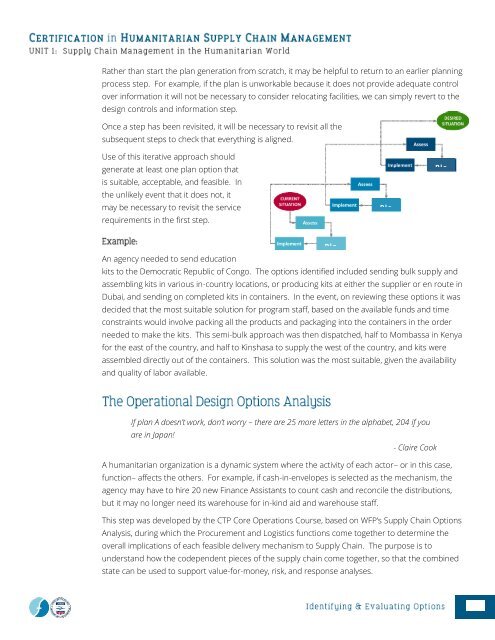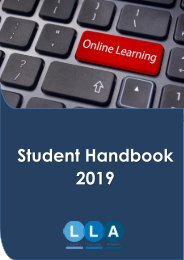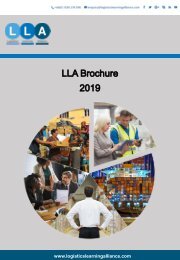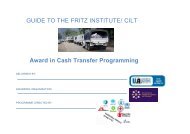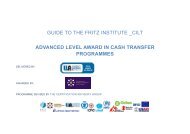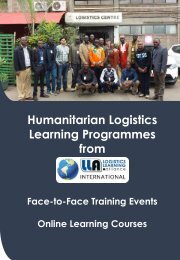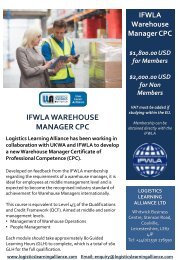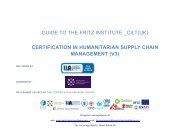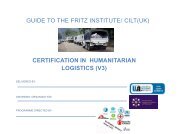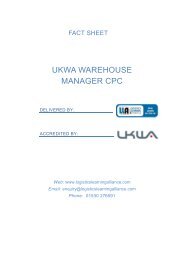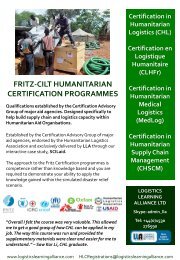CHSCM 3.0 - Unit 1 - SCM in the Humanitarian World
Learning Materials for Unit 1 of the Certification in Humanitarian Supply Chain Management (CHSCM).
Learning Materials for Unit 1 of the Certification in Humanitarian Supply Chain Management (CHSCM).
Create successful ePaper yourself
Turn your PDF publications into a flip-book with our unique Google optimized e-Paper software.
Ra<strong>the</strong>r than start <strong>the</strong> plan generation from scratch, it may be helpful to return to an earlier plann<strong>in</strong>g<br />
process step. For example, if <strong>the</strong> plan is unworkable because it does not provide adequate control<br />
over <strong>in</strong>formation it will not be necessary to consider relocat<strong>in</strong>g facilities, we can simply revert to <strong>the</strong><br />
design controls and <strong>in</strong>formation step.<br />
Once a step has been revisited, it will be necessary to revisit all <strong>the</strong><br />
subsequent steps to check that everyth<strong>in</strong>g is aligned.<br />
Use of this iterative approach should<br />
generate at least one plan option that<br />
is suitable, acceptable, and feasible. In<br />
<strong>the</strong> unlikely event that it does not, it<br />
may be necessary to revisit <strong>the</strong> service<br />
requirements <strong>in</strong> <strong>the</strong> first step.<br />
Pla<br />
n<br />
Pla<br />
n<br />
An agency needed to send education<br />
kits to <strong>the</strong> Democratic Republic of Congo. The options identified <strong>in</strong>cluded send<strong>in</strong>g bulk supply and<br />
assembl<strong>in</strong>g kits <strong>in</strong> various <strong>in</strong>-country locations, or produc<strong>in</strong>g kits at ei<strong>the</strong>r <strong>the</strong> supplier or en route <strong>in</strong><br />
Dubai, and send<strong>in</strong>g on completed kits <strong>in</strong> conta<strong>in</strong>ers. In <strong>the</strong> event, on review<strong>in</strong>g <strong>the</strong>se options it was<br />
decided that <strong>the</strong> most suitable solution for program staff, based on <strong>the</strong> available funds and time<br />
constra<strong>in</strong>ts would <strong>in</strong>volve pack<strong>in</strong>g all <strong>the</strong> products and packag<strong>in</strong>g <strong>in</strong>to <strong>the</strong> conta<strong>in</strong>ers <strong>in</strong> <strong>the</strong> order<br />
needed to make <strong>the</strong> kits. This semi-bulk approach was <strong>the</strong>n dispatched, half to Mombassa <strong>in</strong> Kenya<br />
for <strong>the</strong> east of <strong>the</strong> country, and half to K<strong>in</strong>shasa to supply <strong>the</strong> west of <strong>the</strong> country, and kits were<br />
assembled directly out of <strong>the</strong> conta<strong>in</strong>ers. This solution was <strong>the</strong> most suitable, given <strong>the</strong> availability<br />
and quality of labor available.<br />
Pla<br />
n<br />
If plan A doesn’t work, don’t worry – <strong>the</strong>re are 25 more letters <strong>in</strong> <strong>the</strong> alphabet, 204 if you<br />
are <strong>in</strong> Japan!<br />
- Claire Cook<br />
A humanitarian organization is a dynamic system where <strong>the</strong> activity of each actor– or <strong>in</strong> this case,<br />
function– affects <strong>the</strong> o<strong>the</strong>rs. For example, if cash-<strong>in</strong>-envelopes is selected as <strong>the</strong> mechanism, <strong>the</strong><br />
agency may have to hire 20 new F<strong>in</strong>ance Assistants to count cash and reconcile <strong>the</strong> distributions,<br />
but it may no longer need its warehouse for <strong>in</strong>-k<strong>in</strong>d aid and warehouse staff.<br />
This step was developed by <strong>the</strong> CTP Core Operations Course, based on WFP’s Supply Cha<strong>in</strong> Options<br />
Analysis, dur<strong>in</strong>g which <strong>the</strong> Procurement and Logistics functions come toge<strong>the</strong>r to determ<strong>in</strong>e <strong>the</strong><br />
overall implications of each feasible delivery mechanism to Supply Cha<strong>in</strong>. The purpose is to<br />
understand how <strong>the</strong> codependent pieces of <strong>the</strong> supply cha<strong>in</strong> come toge<strong>the</strong>r, so that <strong>the</strong> comb<strong>in</strong>ed<br />
state can be used to support value-for-money, risk, and response analyses.


